Near-infrared light therapy supercharges your ATP production in multiple ways to enhance your cellular energy. It activates Cytochrome C Oxidase, streamlines electron transport, and breaks harmful nitric oxide bonds in your mitochondria. You'll benefit from improved oxygen utilization, enhanced ATP synthase function, and stronger mitochondrial membrane potential. The therapy optimizes wavelength-specific biostimulation, reduces oxidative stress, and strengthens your cells' stress resistance. NIR light's deep tissue penetration guarantees these benefits reach multiple layers, while repeated exposure creates lasting improvements in your mitochondrial health. Understanding these mechanisms can help you maximize your body's energy production potential.
Cytochrome C Oxidase Activation
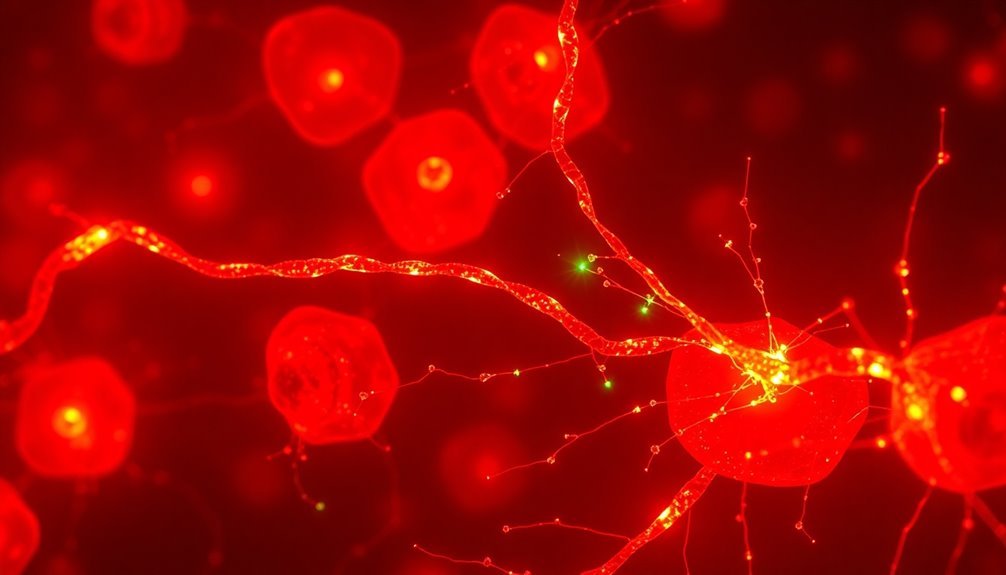
Three key processes define how near-infrared light activates Cytochrome C Oxidase (CCO).
First, when specific wavelengths between 700-1000 nm reach your cells, CCO absorbs these photons in its copper centers. This absorption triggers changes in the enzyme's redox state within your mitochondrial inner membrane, ultimately enhancing its activity and boosting ATP production. The process activates important cellular pathways through cAMP second messengers.
Second, you'll find that CCO serves as your cells' primary photon acceptor during this process. When near-infrared light hits CCO, it stimulates oxidative phosphorylation – your body's primary method for producing cellular energy. This activation leads to improved energy metabolism and increased ATP synthesis, particularly in energy-demanding cells like neurons and muscle tissue.
Third, you'll benefit from CCO's wavelength-specific responses. While wavelengths around 810 nm stimulate CCO activity and increase ATP production, other wavelengths between 750-950 nm can actually inhibit it.
This dual action makes near-infrared light therapy particularly versatile, as you can target different therapeutic needs by selecting specific wavelengths. For instance, you might use stimulatory wavelengths to boost energy production or inhibitory ones to protect against ischemia/reperfusion injury.
Electron Transport Chain Enhancement
When near-infrared light reaches your cells, it markedly enhances the electron transport chain's efficiency within your mitochondria. This enhancement occurs through specific interactions with protein complexes, particularly increasing complex IV activity while reducing complex III activity. The result is a more streamlined flow of electrons that creates a stronger proton gradient to power ATP synthase. Cytochrome C oxidation plays a key role in this process by enhancing oxygen utilization at the cellular level.
| ETC Component | NIR Effect | Cellular Benefit |
|---|---|---|
| Complex IV | Activity Increase | Enhanced electron flow |
| Complex III | Activity Decrease | Regulated redox balance |
| Proton Gradient | Strengthened | More ATP production |
| ATP Synthase | Enhanced Function | Increased energy output |
You'll experience improved cellular energy production as the therapy optimizes electron transfer and reduces oxidative stress. The enhancement doesn't follow typical light-response patterns, suggesting there's a unique mechanism at work beyond simple photochemical reactions. While scientists haven't fully mapped out all the molecular details, they've confirmed that this process leads to increased ATP production, supporting your cells' essential functions. This boost in energy production is particularly significant because it helps your mitochondria operate more efficiently, potentially protecting against various disorders linked to mitochondrial dysfunction.
Breaking Nitric Oxide Bonds
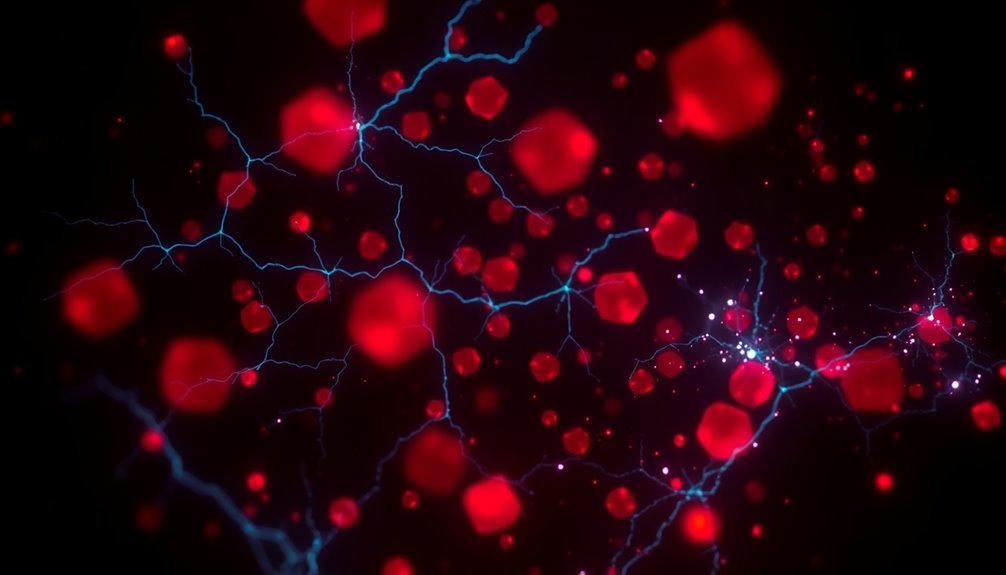
When your mitochondria become clogged with nitric oxide (NO), you'll experience reduced ATP production since NO competes with oxygen for the ATP synthase enzyme.
Near-infrared light directly breaks these NO bonds through photodissociation, effectively releasing this ATP inhibitor from cytochrome c oxidase.
Your mitochondria can then resume ideal ATP production as the freed enzyme sites become available again for oxygen binding and energy generation. This enhanced oxygen utilization creates a more efficient electron transport chain, leading to greater cellular energy output.
Releasing ATP Inhibitors
Located deep within our cells' mitochondria, nitric oxide (NO) acts as a competitive inhibitor that can limit ATP production by binding to cytochrome c oxidase (COX). When NO binds to COX, it blocks the final electron transfer step in oxidative phosphorylation, reducing your cells' ability to synthesize ATP efficiently.
Near-infrared (NIR) light therapy offers a solution through photobiomodulation (PBM). When you receive NIR light treatment, it penetrates your tissues and targets COX directly. The light energy causes photodissociation of NO bonds, effectively breaking NO's grip on COX and restoring proper mitochondrial function. The optimal wavelengths of 760-895 nm are particularly effective at stimulating COX activity.
You'll experience improved electron transport chain efficiency as a result. This process doesn't just stop at breaking bonds – it creates a cascade of positive effects in your cells. Once NO is released, your mitochondria's ATP synthase activity increases, boosting overall ATP production.
You'll benefit from enhanced cellular processes, from muscle contraction to nerve impulses. Research has shown this mechanism's effectiveness in various applications, including athletic performance enhancement and treatment of conditions linked to mitochondrial dysfunction.
Whether you're an athlete looking to improve recovery or managing a health condition, NIR light therapy can help optimize your cellular energy production.
NO Bond Disruption Mechanisms
The precise mechanism behind NO bond disruption reveals the remarkable power of near-infrared light therapy. When near-infrared light hits your cells, it's absorbed by cytochrome c oxidase (CCO), an essential enzyme in your mitochondria. This absorption triggers the photodissociation of nitric oxide (NO) molecules that are bound to CCO, effectively removing their inhibitory effect on cellular respiration. Research has shown that light intensities remain at non-destructive levels during this therapeutic process.
You'll find this process particularly important because NO normally acts as a brake on your mitochondrial function. When near-infrared light breaks these NO bonds, it restores proper electron transport and increases your mitochondrial membrane potential. This leads directly to enhanced ATP production through improved oxidative phosphorylation.
As the NO molecules detach from CCO, you'll experience a cascade of beneficial effects. Your electron transport chain becomes more efficient, and your mitochondrial redox state improves. This process reduces oxidative stress in your cells while boosting energy production.
It's this mechanism that makes near-infrared light therapy so effective for conditions involving mitochondrial dysfunction, including Parkinson's disease and various mitochondrial disorders. The entire process demonstrates how a simple photochemical reaction can greatly impact your cellular energy production.
Mitochondrial Energy Production
Near-infrared light activates your mitochondrial cytochrome c oxidase, directly boosting your electron transport chain's efficiency.
Your mitochondria's enhanced ability to transfer electrons leads to increased ATP production through specific wavelengths between 613-846 nm.
This targeted activation of cytochrome c oxidase improves your cells' energy-producing capacity, creating more ATP to power essential cellular functions. The therapy helps optimize cellular respiration pathways, converting nutrients and oxygen into usable energy more effectively.
Enhanced Electron Transport Chain
Through extensive research, scientists have discovered that near-infrared light greatly enhances the electron transport chain within mitochondria, leading to increased ATP production. When you're exposed to NIR light, it triggers multiple mechanisms that boost your cellular energy production. Mitochondrial efficiency has dramatically improved since its evolutionary origin 1.5-2 billion years ago.
NIR light wavelengths of 850nm and 940nm specifically target cytochrome c oxidase (Complex IV) in your mitochondria, stimulating electron flow through the transport chain. You'll experience increased mitochondrial membrane potential and enhanced ATP synthase activity, which are vital for energy production.
The light also reduces the viscosity of interfacial water layers, making it easier for ATP synthase to rotate and produce more ATP.
You'll benefit from both continuous and pulsed NIR light exposure, as they enhance your mitochondrial function and protect against external stress. This improved electron transport system capacity leads to higher ATP production and better cellular energy levels.
You'll also experience reduced oxidative stress as NIR light helps decrease reactive oxygen species production. These enhancements have therapeutic potential, particularly for conditions involving mitochondrial dysfunction, such as neurodegenerative diseases.
Cytochrome C Oxidase Activation
Diving deeper into cellular energy production, cytochrome c oxidase serves as the primary target for NIR light therapy in your mitochondria. When near-infrared light hits this significant enzyme, it triggers a cascade of beneficial reactions that enhance your cellular energy production.
Your cytochrome c oxidase requires four electrons from cytochrome c to convert oxygen into water, directly influencing how much ATP your cells can produce. When NIR light activates this enzyme, it improves the electron transfer process, leading to increased ATP synthesis and reduced oxidative stress in your cells. At oxygen pressure of 60 torr, respiration rates increase exponentially as more cytochrome c becomes reduced.
You'll find this activation particularly important in high-energy demanding cells like your neurons and muscle cells.
What's fascinating is that NIR light doesn't just temporarily boost cytochrome c oxidase activity – it can also improve your mitochondrial structure and function over time. As the enzyme becomes more efficient, you'll experience enhanced mitochondrial biogenesis and improved cristae morphology.
This optimization of your cellular powerhouses leads to better energy production and metabolic function. The therapeutic effects extend beyond immediate energy boost, as this activation helps maintain the delicate balance between ATP production and reactive oxygen species, supporting your overall cellular health.
Cellular Stress Resistance
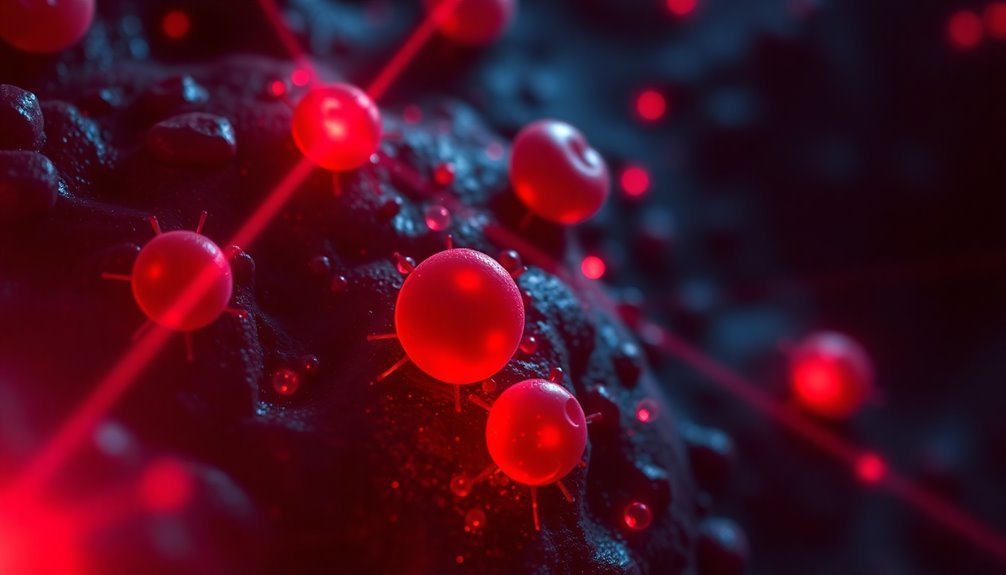
Recent studies have revealed remarkable advances in cellular stress resistance through targeted light therapy protocols. You'll find that specific wavelengths of 830nm and 940nm pulsed light greatly improve your cells' ability to withstand KCl-induced stress, particularly in SH-SY5Y cells.
When you expose cells to near-infrared light, you're activating powerful protective mechanisms. The treatment helps reduce oxidative stress, especially in areas vulnerable to secondary degeneration after CNS injuries. You'll notice this is particularly effective with 670nm NIR light, which prevents abnormal increases in oligodendrocyte precursor cells following partial optic nerve transection. The light stimulates mitochondrial metabolism to enhance cellular protection and repair.
What's fascinating is how NIR light creates a beneficial stress response in your cells. It temporarily increases cellular ROS in inflamed tissues while leaving healthy cells unaffected.
When you apply multiple successive treatments, you'll actually see a decrease in intracellular ROS levels. This process works by modulating the expression of genes responsible for ROS-scavenging enzymes. The result? Your cells become more resilient to external stressors, and you get enhanced cellular protection through this carefully calibrated light exposure protocol.
Deep Tissue ATP Synthesis
Building on cellular stress resistance, near-infrared light's impact on ATP synthesis reveals an even more powerful mechanism at work. When specific wavelengths between 613-846 nm penetrate deep into your tissues, they interact with cytochrome c oxidase (COX) in your mitochondria, enhancing the electron transport chain's efficiency and boosting ATP production.
You'll get the best results with light intensities between 0.8-1.1 W, as they optimize ATP synthesis without inducing oxidative stress. The process works by helping COX utilize oxygen more effectively while reducing nitric oxide binding, which can inhibit energy production.
When you expose your tissues to near-infrared light for 30-60 seconds, you're triggering a thermodynamic process that converts electromagnetic energy into chemical energy.
What's particularly impressive is that this therapy doesn't just boost ATP production – it actually increases the number of mitochondria in your cells. You'll find this beneficial for muscle recovery, skin rejuvenation, and even neurological health.
The light therapy's ability to reduce reactive oxygen species while promoting energy production makes it a powerful tool for enhancing your cellular health and performance.
Wavelength-Specific Biostimulation Effects
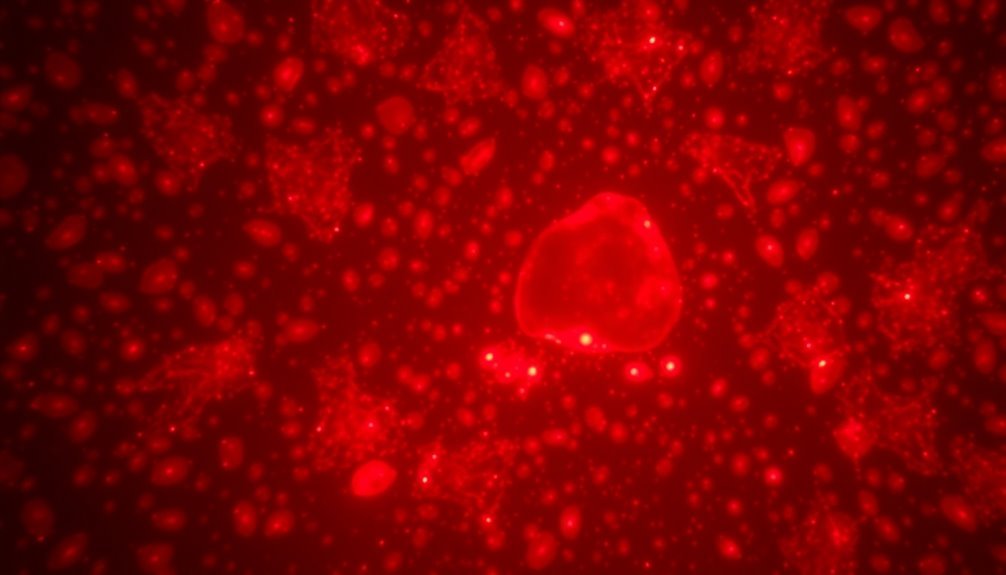
Near-infrared light's ability to boost ATP production depends heavily on specific wavelength ranges, with ideal frequencies falling between 750-772 nm and 812-846 nm for deep cellular biostimulation.
You'll find that different wavelengths penetrate tissue at varying depths, making wavelength selection essential for targeting specific cellular structures and achieving desired therapeutic outcomes.
The most effective ATP production occurs when you use light in the 760-895 nm range, which effectively stimulates cytochrome c oxidase and enhances electron transport chain efficiency.
Optimal NIR Light Wavelengths
Several specific wavelengths within the near-infrared spectrum have proven optimal for boosting ATP production, with the most effective range falling between 600-900 nm.
When you're looking at specific wavelengths, 810 nm stands out for enhancing mitochondrial energy output, while 670 nm reduces inner mitochondrial water layer viscosity to improve ATP synthase function. You'll find that 908 nm light effectively increases ATP production by interacting with complexes III and IV in the mitochondrial electron transport chain.
You'll need to pay attention to both wavelength and power settings for ideal results. While 980 nm can work well at higher powers, it won't help much at lower intensities.
The key mechanism you should understand is how NIR light interacts with cytochrome c oxidase, which enhances electron transport and ATP production. This interaction helps dissociate nitric oxide from cytochrome c oxidase, improving oxygen utilization and ATP synthesis.
When you're applying NIR light therapy, remember that intensity and duration matter greatly. You'll get better results using higher power levels (0.8-1.1 W) compared to lower ones, and pulsed NIR light can be particularly effective for enhancing metabolism in stressed cells.
Cell Penetration By Frequency
Light penetration through biological tissues varies dramatically across the electromagnetic spectrum, with the therapeutic window falling between 650-1360nm.
You'll find that near-infrared light (NIR) between 750-950nm achieves the deepest tissue penetration, making it particularly effective for cellular biostimulation.
Research demonstrates that 808nm wavelengths penetrate notably deeper than shorter wavelengths, with remarkable tissue-specific capabilities:
- In muscle tissue, 808nm light reaches 2.3 times deeper than 405nm light, allowing for effective treatment of deep muscle conditions.
- Through chicken tissue, 808nm penetrates 2.4 times deeper than 405nm light, with high-frequency variants reaching up to 7.4 times deeper.
- In rat studies, 808nm light maintains 6% power transmission even after passing through 18mm of tissue.
- Within bovine tissue, 810nm light can penetrate an impressive 3.4cm deep.
When you're targeting cellular ATP production, these penetration depths become essential.
The deeper penetration of NIR wavelengths guarantees that light reaches mitochondria in deeper tissue layers, activating cytochrome c oxidase and triggering the cellular energy production cascade more effectively than shorter wavelengths. The systemic benefits of NIR extend beyond the direct treatment area, promoting healing throughout the body.
Metabolic Energy Optimization
According to recent research, metabolic energy production gets a significant boost from red and near-infrared light therapy through multiple mechanisms. When specific wavelengths of light interact with your cells' mitochondria, they enhance the electron transport chain's efficiency and directly stimulate ATP production.
You'll find that certain wavelengths (613-623 nm, 750-772 nm, and 812-846 nm) are particularly effective at stimulating cellular functions. The light interacts with cytochrome c oxidase in Complex IV and cytochrome b in Complex III, improving oxygen utilization and electron transfer. This process helps break up nitric oxide bonds, allowing H+ ions to move more effectively through the system.
Near-infrared light also optimizes ATP synthase function by reducing the viscosity of the intermembrane space and preventing nitric oxide inhibition. The process converts electromagnetic energy into chemical energy through photobiomodulation (PBM), with a maximal energy production rate of around 0.2%.
While this percentage might seem small, it's significant enough to enhance your cellular energy balance and improve overall metabolic function through more efficient cellular respiration.
Oxidative Stress Reduction
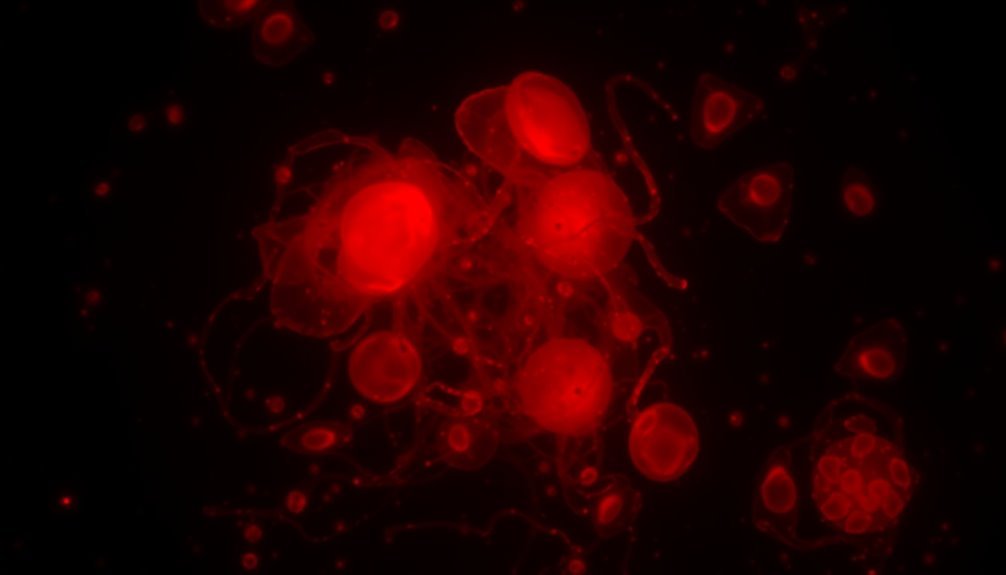
Managing oxidative stress becomes considerably more effective through near-infrared light therapy's multifaceted approach to cellular protection. When you're exposed to near-infrared light, your cells activate powerful defense mechanisms that combat harmful reactive oxygen species (ROS) while enhancing mitochondrial function.
This dual-action approach not only protects your cells but also improves their natural ability to produce energy efficiently.
Your body's oxidative stress reduction response includes:
- Enhanced mitochondrial membrane potential, leading to improved ATP production and reduced electron leakage that can cause oxidative damage
- Activation of ROS-scavenging enzymes that actively lower cellular ROS concentrations and regulate nitric oxide levels
- Downregulation of inflammatory cytokines, particularly those triggered by harmful proteins like the SARS-CoV-2 spike
- Strengthened cellular protection through repeated NIR light exposures, creating a cumulative anti-inflammatory effect
The therapy's impact on oxidative stress isn't just temporary – it creates lasting changes in your cellular environment.
ATP Synthase Activity Boost
Building on near-infrared light's powerful antioxidant effects, its ability to boost ATP synthase activity represents another remarkable cellular benefit. When near-infrared light hits your cells, it enhances the electron transport chain's efficiency by increasing cytochrome c oxidase activity, leading to higher ATP production.
You'll find that specific wavelengths between 620-680 nm and 760-895 nm are particularly effective, as they're ideally absorbed by cytochrome c oxidase. The light works through two main mechanisms: it photodissociates nitric oxide from oxygen binding sites and reduces intermembrane viscosity.
When nitric oxide is removed, it stops competing with oxygen, allowing your ATP synthase to work more efficiently. The power intensity matters considerably for these benefits. You'll need light within the 0.8-1.1 W range for ideal ATP production, as lower powers (0.1 W) can actually inhibit ATP synthesis.
The physical effects happen quickly, as the reduced intermembrane viscosity immediately enhances ATP synthase rotation. Through these combined mechanisms, near-infrared light therapy can boost your mitochondrial energy production by improving oxygen utilization and electron transport efficiency.
Frequently Asked Questions
How Long Does It Take to See Results From Near-Infrared Light Therapy?
You'll notice initial effects like relaxation immediately, but significant results take 4-12 weeks of consistent treatment. For ideal benefits, you'll need regular sessions, as individual response times can vary based on your goals.
Can Near-Infrared Light Therapy Be Combined With Other Energy-Boosting Treatments?
Yes, you can safely combine NIR light therapy with other energy-boosting treatments like pre-workout routines, massage therapy, and conventional medical treatments. This combination often enhances overall results and accelerates healing benefits.
What Time of Day Is Most Effective for Near-Infrared Light Exposure?
You'll get the best results from near-infrared light exposure in the morning or early daytime hours. It aligns with your natural circadian rhythm and helps maximize energy production while avoiding potential sleep disruptions.
Does Eating Before or After Near-Infrared Therapy Affect ATP Production Results?
While there's no direct evidence that meal timing affects ATP production during near-infrared therapy, you'll likely benefit from eating after your session when your cells are primed for enhanced nutrient uptake.
How Often Should Near-Infrared Light Therapy Be Used for Optimal Results?
You'll get ideal results using near-infrared light therapy 5-7 times weekly for 10-20 minutes per session. After seeing improvements, you can reduce frequency to 2-3 times weekly for maintenance.
In Summary
You've now learned how near-infrared light can dramatically boost your cellular energy through multiple pathways. From activating cytochrome c oxidase to enhancing your electron transport chain, you're equipped to harness this powerful therapy. By understanding these mechanisms, you'll optimize your mitochondrial function and ATP production. Whether you're an athlete or seeking better health, near-infrared light therapy can help you achieve peak cellular performance.





Leave a Reply